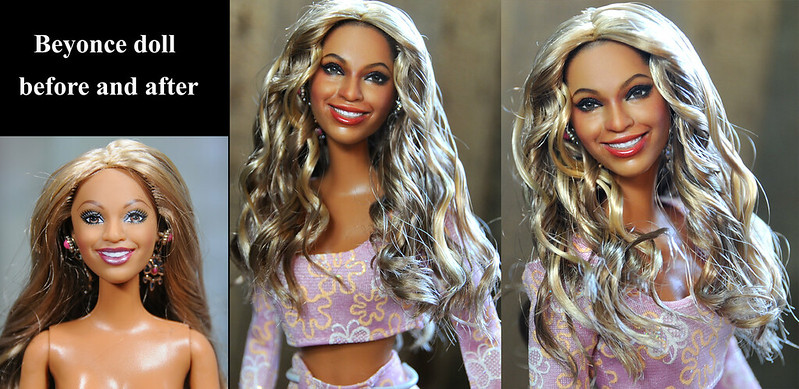Dolls are one of the most versatile toys when it comes to children's imaginative games, however fantasy has no age and they keep being a wonderful canvas for adults as well. What happens when a doll collector is also an artist? The two passions join together and the result is a fascinating niche hobby commonly called doll customizing. The customization of dolls exists in many forms and degrees of modification: the range goes from any alteration between changing clothes or hair, painting a new face, and even creating a hybrid by putting together parts of different dolls or sculpting completely new parts!
 |
| Kid Delf Hanael by Hina Ichigo on Flickr |
In the early 2000s the artists and collectors’ favorite objects were garage kits (resin kits that let you piece together and paint a figurine by yourself) and especially the great novelty of the time: the BJDs, that is Ball Jointed Dolls. These resin dolls, introduced by Japanese company Volks in 1999 and since then produced in different forms by many companies in the world, are characterized by their very versatile spherical joints that allow posing in many more positions than a classic doll like Barbie. Furthermore, the possibility to change the removable eyes and hair with the wigs greatly increases the level of customization, letting the artist change character or aesthetic whenever they want.
In that period doll customizing was generally a challenging and a bit expensive hobby, but the debut of a particular line of fashion dolls (dolls mainly designed to be dressed up and represent fashions) revolutionized the landscape of this hobby. In 2010 Mattel launched the Monster High doll line, which is very peculiar for different reasons. The dolls represent characters with defined aesthetics and personalities (among their accessories they have a small diary with their story): daughters or relatives of iconic figures of the horror scene such as Frankestein or Dracula, these girls go to a school full of teen monsters, following the slogan “Be Yourself, Be Unique, Be a Monster”. The characters’ aesthetic brings together the horror themes with the charming creepy cute fashion: the dolls have particular clothes and accessories full of details based on each character.
 |
| The first group of dolls from Monster High's original line (2010) |
Monster High dolls, being fashion dolls and thus designed as toys and not collectors’ items, presented a more compact and cheaper alternative to bjds. Infact, with the average size of a Barbie and double the articulations, these girls not only conquered the hearts of many children, but they also contributed to the accessibility of the hobby to a larger group of artists.
In the span of 12 years, the doll market was filled with models of different shapes and sizes, for the joy of fans. Likewise, the concept of customization evolved in different forms. The term used in the community is OOAK (One Of A Kind), which means a unique piece. One of the most known artists even outside of the community is Filipino artist Noel Cruz, known for his incredible skills with the paintbrush, which gives great realism and life to his dolls, most of which represent celebrities. For example, here is his work with the Beyoncé doll:
Dolls can represent a favorite character, a mythological creature (werewolves, fairies, minotaurs) or even a concept (seasons, zodiac signs, arcana of the tarots. Depending on the artist’s vision, in order to bring this idea to light you need to modify the dolls with clay, resin or other materials. On YouTube you can find wonderful examples of OOAK dolls by artists such as Dollightful, Hextian, Dollmotion, Kyros Workshop, Enchanterium, Valkitty’s World, Doe Deer Wonderland (who takes care of restoring vintages pieces), Kiat B. Saguru and many others. Here I propose some gorgeous works:
Closer to the concept of restoration is the idea of customizing dolls with the goal to create the illusion that they are factory made this way. Did your character not get a doll in the line dedicated to their film or series? Well, you can make it yourself, with the right materials! The couple of aficionados of dolls and mahou shoujo genre Cosmo and Luke have been showing for many years their collection on their YouTube channel and website Latte e Cartoni (formerly curemoon.com), together with their custom dolls. For instance, Luke managed to create dolls of the Sailor Starlights warriors from the series Sailor Moon Sailor Stars, which were never produced in Italy by Giochi Preziosi, using other pieces from the same line and clothes created with the closest material possible to those of the official products.
Through the years, Luke created with this method a great number of dolls from series such as Sailor Moon, Pretty Cure, Wedding Peach and Mermaid Melody Pitchi Pitchi Pitch for his collection and on commission as well. In a relatively recent video, Luke and Cosmo showed the three official dolls of Mermaid Melody by Giochi Preziosi (the protagonists Lucia in pink, Hanon in light blue and Rina in green) accompanied by the custom dolls of the rest of the group present in the series. The fact that you cannot recognize the factory made piece from the hand made one is proof of great skills and attention to details. The YouTube channel, among other content related to cartoons and toys, presents a few tutorials that can be watched in this playlist.
Any modification, from the smallest to the most complex, transforms a doll into a unique piece. That’s the beauty of this hobby: there is not one single way to customize, but infinite possibilities at the service of the fantasy of someone who keeps playing and imagining.
















